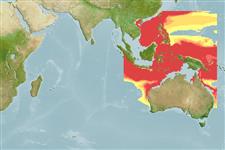Environment: milieu / climate zone / depth range / distribution range
Ecologia
marino batipelagico; distribuzione batimetrica 165 - 208 m (Ref. 57178). Deep-water; 26°N - 32°S, 99°E - 155°E (Ref. 57278)
Indo-West Pacific: Japan, Indonesia and Australia.
Size / Peso / Age
Maturity: Lm ? range ? - ? cm
Max length : 20.0 cm SL maschio/sesso non determinato; (Ref. 559)
Short description
Chiavi di identificazione | Morfologia | Morfometria
Spine dorsali (totale) : 10; Raggi dorsali molli (totale) : 9 - 10; Spine anali: 3; Raggi anali molli: 7; Vertebre: 10 - 15. Body shape and color similar to M. wakiyai and M. griseus, but differs by having a more slender body, 7 soft rays in the anal fin, and a hollow 1st pterygiophore of anal fin (Ref. 559). First proximal radials hollow (Ref. 40964).
Occurs in the continental slope (Ref. 7300).
Life cycle and mating behavior
Maturità | Riproduzione | Deposizione | Uova | Fecundity | Larve
Paxton, J.R., D.F. Hoese, G.R. Allen and J.E. Hanley, 1989. Pisces. Petromyzontidae to Carangidae. Zoological Catalogue of Australia, Vol. 7. Australian Government Publishing Service, Canberra, 665 p. (Ref. 7300)
IUCN Red List Status (Ref. 130435: Version 2024-2)
Threat to humans
Harmless
Human uses
Strumenti
Special reports
Download XML
Fonti Internet
Estimates based on models
Preferred temperature (Ref.
123201): 14.3 - 20.6, mean 16 °C (based on 20 cells).
Phylogenetic diversity index (Ref.
82804): PD
50 = 0.5078 [Uniqueness, from 0.5 = low to 2.0 = high].
Bayesian length-weight: a=0.00468 (0.00180 - 0.01218), b=3.13 (2.90 - 3.36), in cm total length, based on LWR estimates for this (Sub)family-body shape (Ref.
93245).
Trophic level (Ref.
69278): 3.7 ±0.5 se; based on size and trophs of closest relatives
Fishing Vulnerability (Ref.
59153): Low vulnerability (14 of 100).
